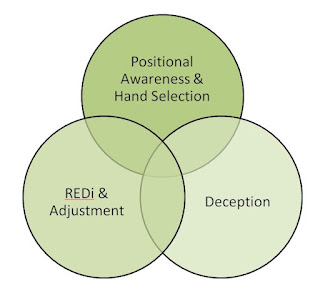While I believe ultimately that the original blog post missed a couple of key things, the author did get much of it right. More importantly, he made me think. A lot, in fact. And that is always a very good thing. Sometimes just putting one's thoughts down on paper (virtual or otherwise) is enough to spur someone else to take that idea and move it forward, expanding and reworking as necessary to improve the global understanding. And that's precisely what I've attempted to do here.
Long-time readers of this blog know that I periodically get spun up about the whole concept of "edge" and how maximizing these edges are the pathway to profit. I strongly believe that the secret to making money at poker lies buried within Roy Cooke's equation that states Expectation (or Profit) is simply Volume multiplied by Edge. Volume is easy to address (just play more hands); it's the edge part that's harder to improve. Hell, it's hard just to define. I've struggled with this notion on and off for a while here in the pages of this blog... and, well, here I go again...
After a long day spent sweating in the desert sun yesterday, pounding fencing t-posts into the baked ground while my equally-baked brain chewed over this problem, I came up with the following. In short, I think we can break the traits of most winning poker players into three general, but overlapping, categories. I call these: 1) technical proficiency; 2) preparation; and 3) emotional control. Here's a simple visual representation of what I mean:
 |
| The Three Core Aspects of Poker Mastery |
To be great at poker, I believe you need to master all three of these traits and skills. Each is vitally important, and none is any less important than the other two. For some people, learning the technical skills of poker (e.g., REDi, positional awareness, etc.) is the easy part, while mastering the "emotional" side proves to be much more difficult (e.g., tilt, discipline, etc.). For others, the opposite is true. And yet still other players might have those two parts under control, but do a poor job in the third category of preparation (e.g., game selection, etc.). Or vice versa.
To extend this idea a little further, I think there are three major skill or trait subsets upon which each of these three core abilities is built. For example, technical proficiency really breaks down into 1) positional awareness & starting hand selection; 2) REDi skills (and the ability to adjust); and 3) the ability to deceive your opponents and induce them to make mistakes**:
 |
| The Three Core Categories of Technical Proficiency |
Similarly, emotional control can be subdivided into three separate, but overlapping abilities: 1) the discipline to play perfect poker regardless of outcomes (RDM); 2) bankroll protection and the ability to play at the correct stakes; and 3) the awareness and resistance of tilt:
 |
| The Three Core Parts of Emotional Control |
And, finally, preparedness can be thought of as being performed in three distinct phases, or subparts: 1) pregame preparation and game selection; 2) post-game hand and game reviews, including leak plugging; and 3) study & improvement done away from the tables:
 |
| The Three Core Phases of Preparation |
The more I stare at this breakdown, the more it makes sense. I also believe that this can serve as the framework upon which a player can build his or her own game....
...or at the very least, serve as a starting point for someone else to take these ideas and rework them yet again into their own thoughts and blog posting. We're all in this poker mastery quandary thing together after all, right?
All-in for now...
-Bug
*If you're interested, you can read the original blog post that got me thinking here.
** Note that these three categories (Position/Starting Hand Selection, REDi, and Deception) correspond almost directly with level-1, level-2, and level-3 poker thought/analysis, respectively. Pretty cool, huh?
No comments:
Post a Comment